Consumer Behavior Analysis: Chanel 2.55 Handbag and Market Segments
VerifiedAdded on 2022/11/01
|12
|2789
|146
Report
AI Summary
This report provides a detailed analysis of consumer behavior in the context of the Chanel 2.55 handbag. It begins by defining the concept of consumer involvement and its relevance to luxury products like the Chanel 2.55. The report then identifies and profiles the target market segments for the handbag, considering demographic, geographic, behavioral, and psychographic variables. Following this, the paper examines the consumer decision-making process, breaking down the stages from problem recognition to post-purchase behavior, and analyzes how these stages apply to the Chanel 2.55. The report also explores the influencing factors on consumer behavior, particularly the snob effect, and offers recommendations for Chanel, such as product diversification and premium pricing strategies. The report concludes by emphasizing the differences between mass-market and premium product consumer behavior and highlights the importance of maintaining the exclusivity of the Chanel 2.55 brand.
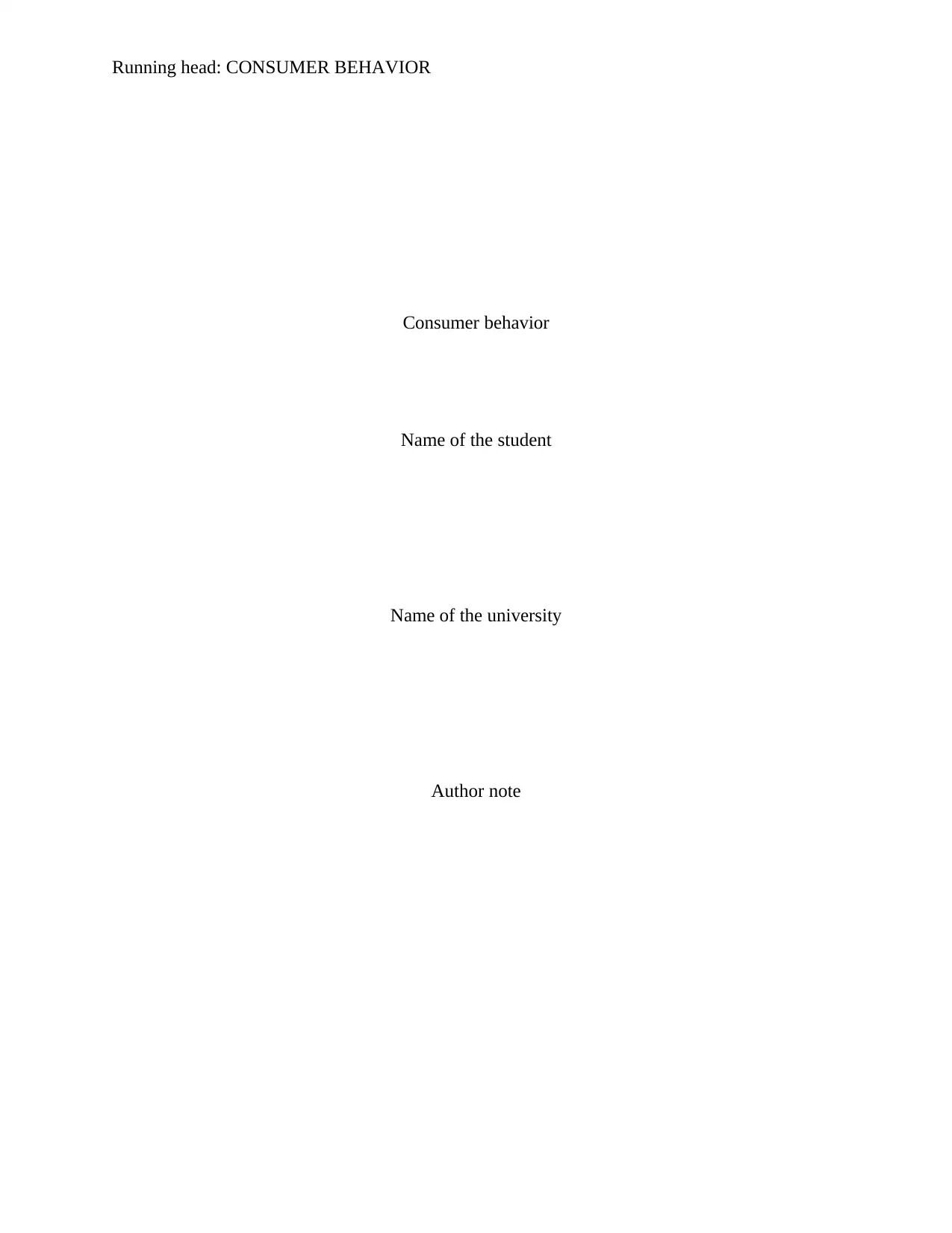
Running head: CONSUMER BEHAVIOR
Consumer behavior
Name of the student
Name of the university
Author note
Consumer behavior
Name of the student
Name of the university
Author note
Paraphrase This Document
Need a fresh take? Get an instant paraphrase of this document with our AI Paraphraser
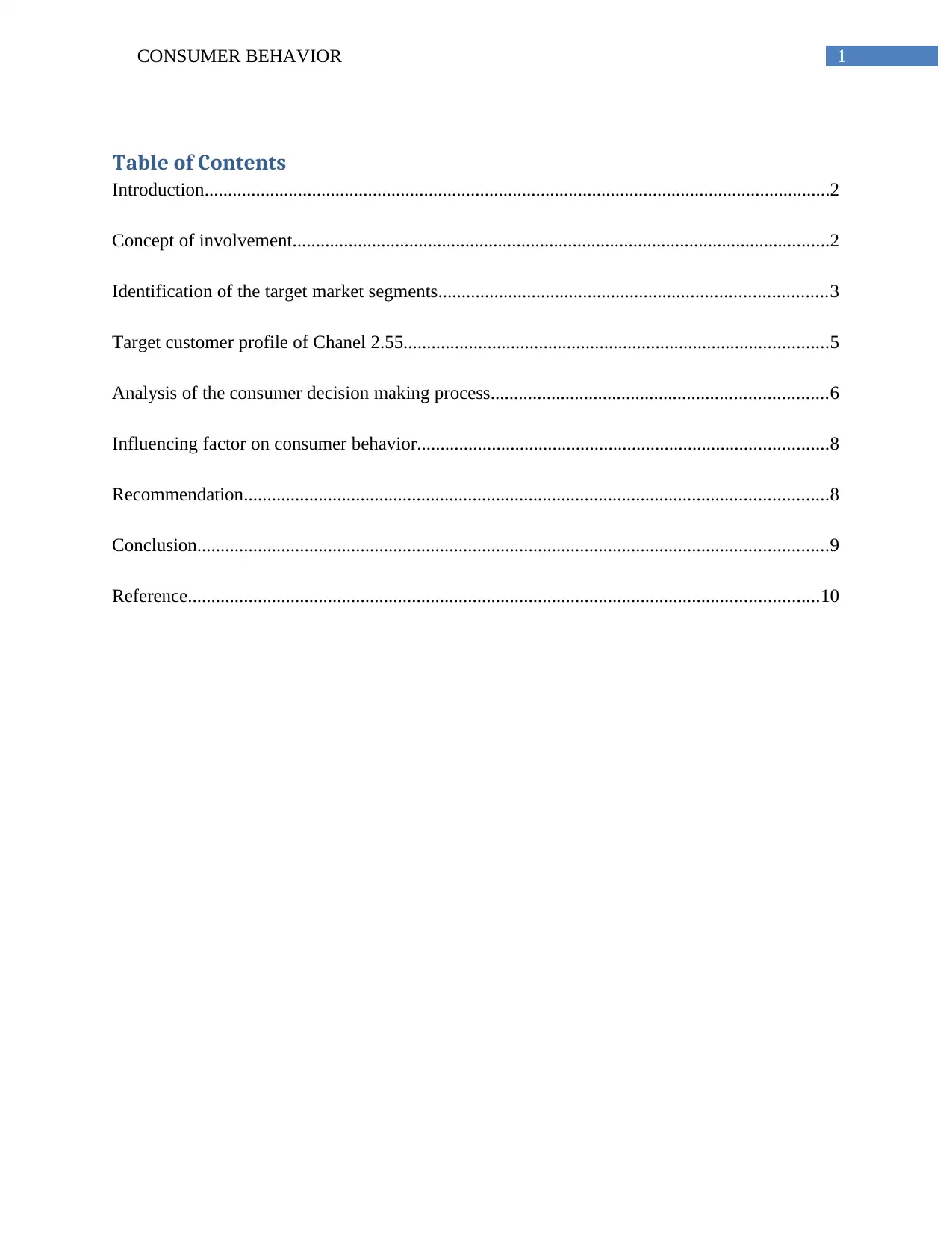
1CONSUMER BEHAVIOR
Table of Contents
Introduction......................................................................................................................................2
Concept of involvement...................................................................................................................2
Identification of the target market segments...................................................................................3
Target customer profile of Chanel 2.55...........................................................................................5
Analysis of the consumer decision making process........................................................................6
Influencing factor on consumer behavior........................................................................................8
Recommendation.............................................................................................................................8
Conclusion.......................................................................................................................................9
Reference.......................................................................................................................................10
Table of Contents
Introduction......................................................................................................................................2
Concept of involvement...................................................................................................................2
Identification of the target market segments...................................................................................3
Target customer profile of Chanel 2.55...........................................................................................5
Analysis of the consumer decision making process........................................................................6
Influencing factor on consumer behavior........................................................................................8
Recommendation.............................................................................................................................8
Conclusion.......................................................................................................................................9
Reference.......................................................................................................................................10
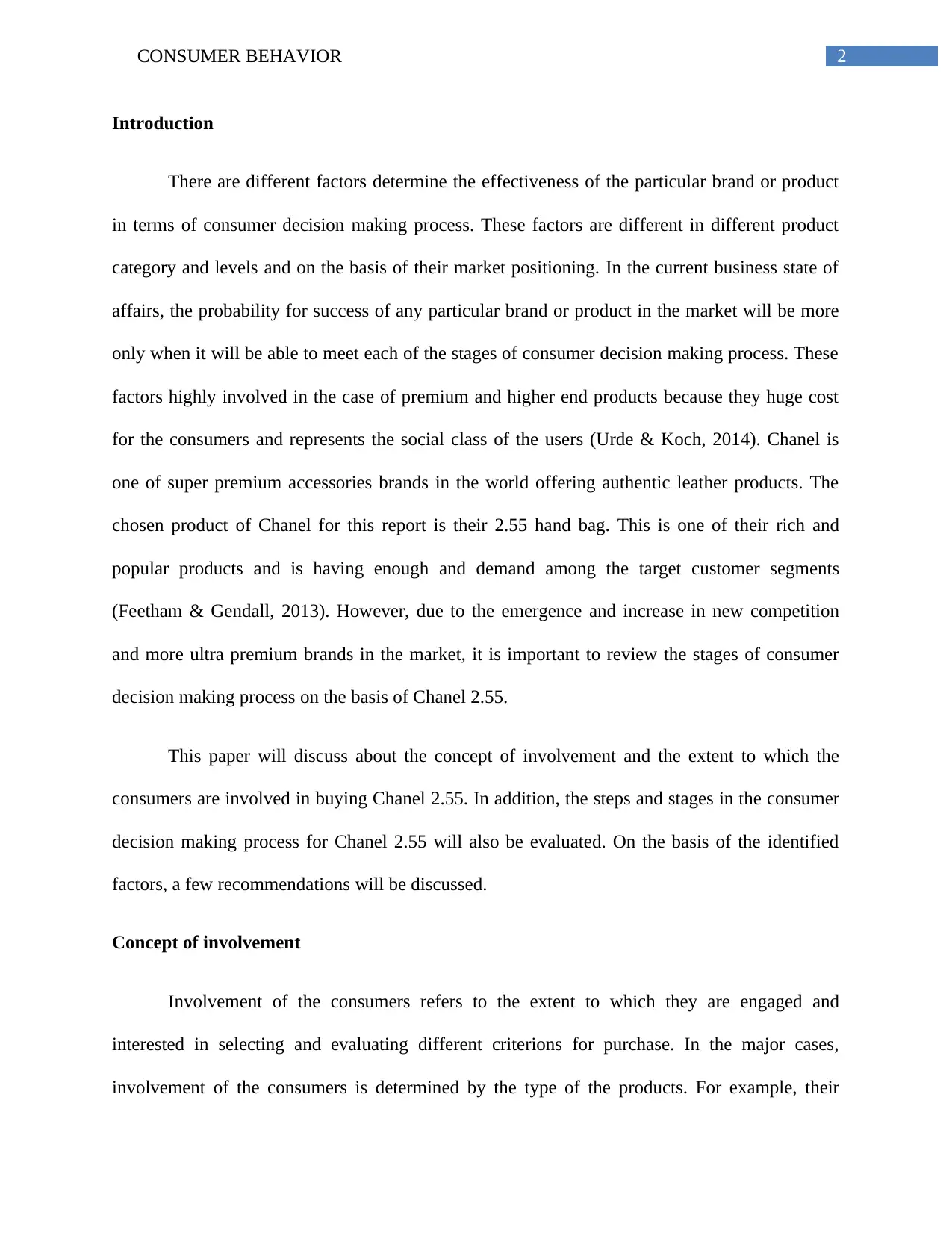
2CONSUMER BEHAVIOR
Introduction
There are different factors determine the effectiveness of the particular brand or product
in terms of consumer decision making process. These factors are different in different product
category and levels and on the basis of their market positioning. In the current business state of
affairs, the probability for success of any particular brand or product in the market will be more
only when it will be able to meet each of the stages of consumer decision making process. These
factors highly involved in the case of premium and higher end products because they huge cost
for the consumers and represents the social class of the users (Urde & Koch, 2014). Chanel is
one of super premium accessories brands in the world offering authentic leather products. The
chosen product of Chanel for this report is their 2.55 hand bag. This is one of their rich and
popular products and is having enough and demand among the target customer segments
(Feetham & Gendall, 2013). However, due to the emergence and increase in new competition
and more ultra premium brands in the market, it is important to review the stages of consumer
decision making process on the basis of Chanel 2.55.
This paper will discuss about the concept of involvement and the extent to which the
consumers are involved in buying Chanel 2.55. In addition, the steps and stages in the consumer
decision making process for Chanel 2.55 will also be evaluated. On the basis of the identified
factors, a few recommendations will be discussed.
Concept of involvement
Involvement of the consumers refers to the extent to which they are engaged and
interested in selecting and evaluating different criterions for purchase. In the major cases,
involvement of the consumers is determined by the type of the products. For example, their
Introduction
There are different factors determine the effectiveness of the particular brand or product
in terms of consumer decision making process. These factors are different in different product
category and levels and on the basis of their market positioning. In the current business state of
affairs, the probability for success of any particular brand or product in the market will be more
only when it will be able to meet each of the stages of consumer decision making process. These
factors highly involved in the case of premium and higher end products because they huge cost
for the consumers and represents the social class of the users (Urde & Koch, 2014). Chanel is
one of super premium accessories brands in the world offering authentic leather products. The
chosen product of Chanel for this report is their 2.55 hand bag. This is one of their rich and
popular products and is having enough and demand among the target customer segments
(Feetham & Gendall, 2013). However, due to the emergence and increase in new competition
and more ultra premium brands in the market, it is important to review the stages of consumer
decision making process on the basis of Chanel 2.55.
This paper will discuss about the concept of involvement and the extent to which the
consumers are involved in buying Chanel 2.55. In addition, the steps and stages in the consumer
decision making process for Chanel 2.55 will also be evaluated. On the basis of the identified
factors, a few recommendations will be discussed.
Concept of involvement
Involvement of the consumers refers to the extent to which they are engaged and
interested in selecting and evaluating different criterions for purchase. In the major cases,
involvement of the consumers is determined by the type of the products. For example, their
⊘ This is a preview!⊘
Do you want full access?
Subscribe today to unlock all pages.

Trusted by 1+ million students worldwide
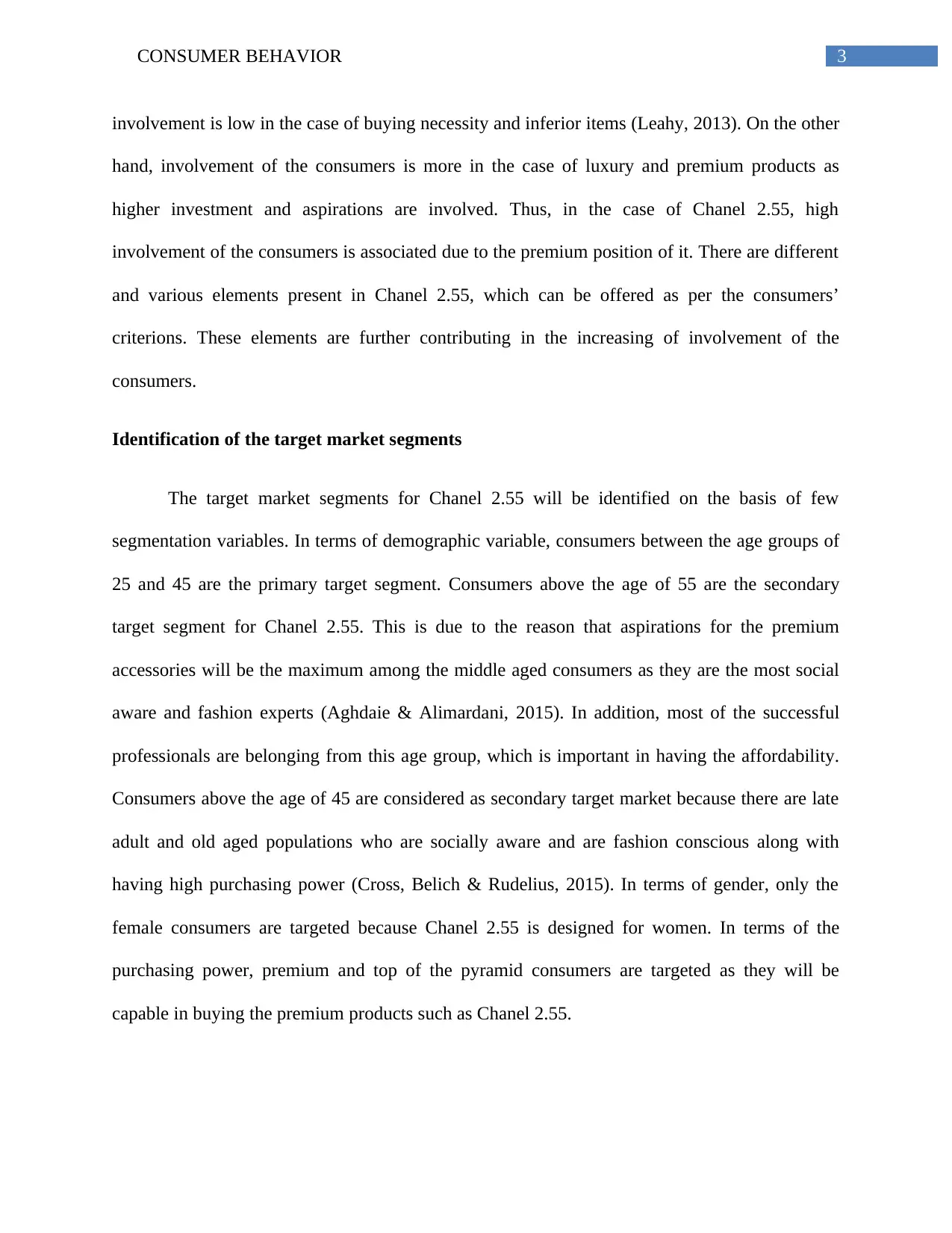
3CONSUMER BEHAVIOR
involvement is low in the case of buying necessity and inferior items (Leahy, 2013). On the other
hand, involvement of the consumers is more in the case of luxury and premium products as
higher investment and aspirations are involved. Thus, in the case of Chanel 2.55, high
involvement of the consumers is associated due to the premium position of it. There are different
and various elements present in Chanel 2.55, which can be offered as per the consumers’
criterions. These elements are further contributing in the increasing of involvement of the
consumers.
Identification of the target market segments
The target market segments for Chanel 2.55 will be identified on the basis of few
segmentation variables. In terms of demographic variable, consumers between the age groups of
25 and 45 are the primary target segment. Consumers above the age of 55 are the secondary
target segment for Chanel 2.55. This is due to the reason that aspirations for the premium
accessories will be the maximum among the middle aged consumers as they are the most social
aware and fashion experts (Aghdaie & Alimardani, 2015). In addition, most of the successful
professionals are belonging from this age group, which is important in having the affordability.
Consumers above the age of 45 are considered as secondary target market because there are late
adult and old aged populations who are socially aware and are fashion conscious along with
having high purchasing power (Cross, Belich & Rudelius, 2015). In terms of gender, only the
female consumers are targeted because Chanel 2.55 is designed for women. In terms of the
purchasing power, premium and top of the pyramid consumers are targeted as they will be
capable in buying the premium products such as Chanel 2.55.
involvement is low in the case of buying necessity and inferior items (Leahy, 2013). On the other
hand, involvement of the consumers is more in the case of luxury and premium products as
higher investment and aspirations are involved. Thus, in the case of Chanel 2.55, high
involvement of the consumers is associated due to the premium position of it. There are different
and various elements present in Chanel 2.55, which can be offered as per the consumers’
criterions. These elements are further contributing in the increasing of involvement of the
consumers.
Identification of the target market segments
The target market segments for Chanel 2.55 will be identified on the basis of few
segmentation variables. In terms of demographic variable, consumers between the age groups of
25 and 45 are the primary target segment. Consumers above the age of 55 are the secondary
target segment for Chanel 2.55. This is due to the reason that aspirations for the premium
accessories will be the maximum among the middle aged consumers as they are the most social
aware and fashion experts (Aghdaie & Alimardani, 2015). In addition, most of the successful
professionals are belonging from this age group, which is important in having the affordability.
Consumers above the age of 45 are considered as secondary target market because there are late
adult and old aged populations who are socially aware and are fashion conscious along with
having high purchasing power (Cross, Belich & Rudelius, 2015). In terms of gender, only the
female consumers are targeted because Chanel 2.55 is designed for women. In terms of the
purchasing power, premium and top of the pyramid consumers are targeted as they will be
capable in buying the premium products such as Chanel 2.55.
Paraphrase This Document
Need a fresh take? Get an instant paraphrase of this document with our AI Paraphraser
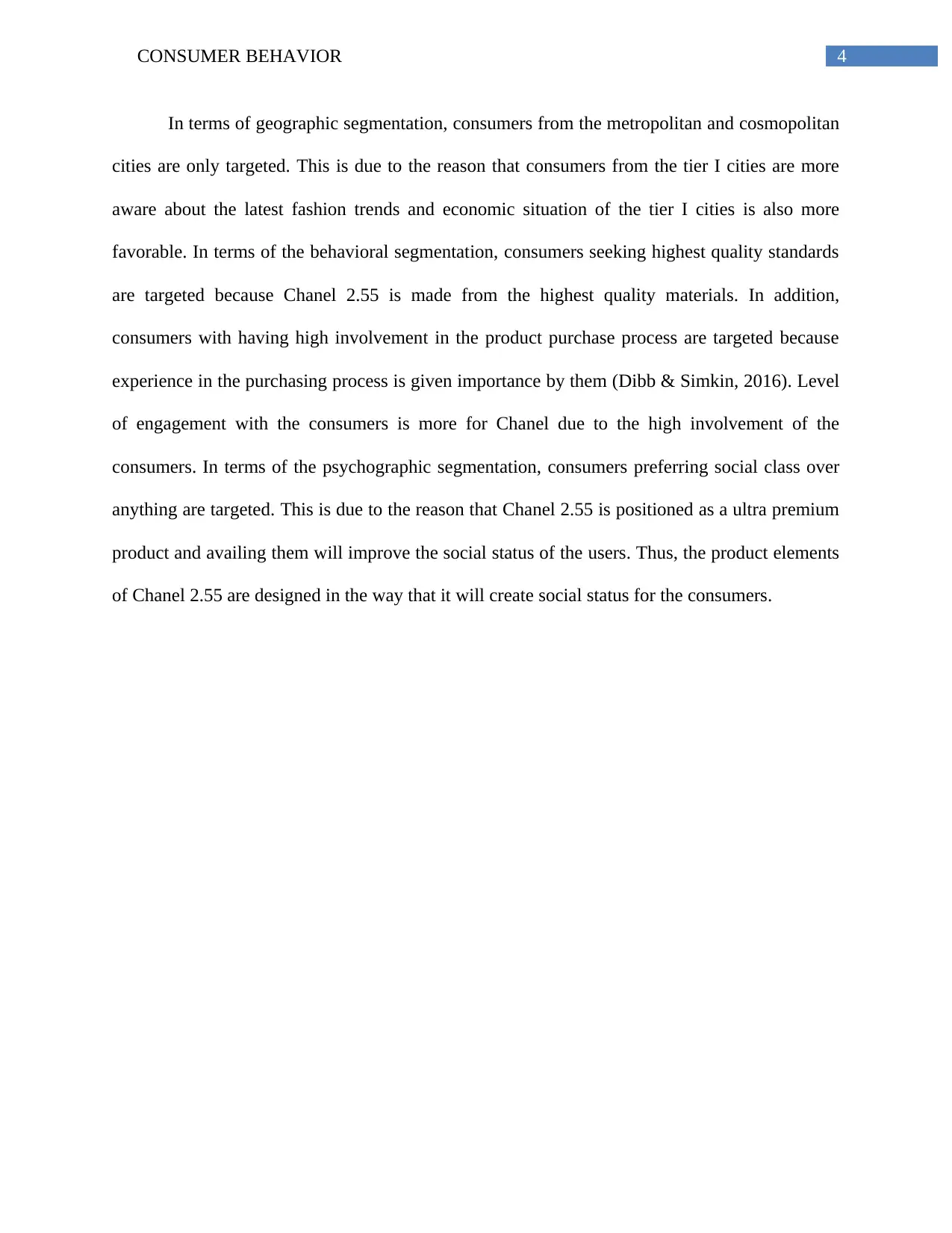
4CONSUMER BEHAVIOR
In terms of geographic segmentation, consumers from the metropolitan and cosmopolitan
cities are only targeted. This is due to the reason that consumers from the tier I cities are more
aware about the latest fashion trends and economic situation of the tier I cities is also more
favorable. In terms of the behavioral segmentation, consumers seeking highest quality standards
are targeted because Chanel 2.55 is made from the highest quality materials. In addition,
consumers with having high involvement in the product purchase process are targeted because
experience in the purchasing process is given importance by them (Dibb & Simkin, 2016). Level
of engagement with the consumers is more for Chanel due to the high involvement of the
consumers. In terms of the psychographic segmentation, consumers preferring social class over
anything are targeted. This is due to the reason that Chanel 2.55 is positioned as a ultra premium
product and availing them will improve the social status of the users. Thus, the product elements
of Chanel 2.55 are designed in the way that it will create social status for the consumers.
In terms of geographic segmentation, consumers from the metropolitan and cosmopolitan
cities are only targeted. This is due to the reason that consumers from the tier I cities are more
aware about the latest fashion trends and economic situation of the tier I cities is also more
favorable. In terms of the behavioral segmentation, consumers seeking highest quality standards
are targeted because Chanel 2.55 is made from the highest quality materials. In addition,
consumers with having high involvement in the product purchase process are targeted because
experience in the purchasing process is given importance by them (Dibb & Simkin, 2016). Level
of engagement with the consumers is more for Chanel due to the high involvement of the
consumers. In terms of the psychographic segmentation, consumers preferring social class over
anything are targeted. This is due to the reason that Chanel 2.55 is positioned as a ultra premium
product and availing them will improve the social status of the users. Thus, the product elements
of Chanel 2.55 are designed in the way that it will create social status for the consumers.
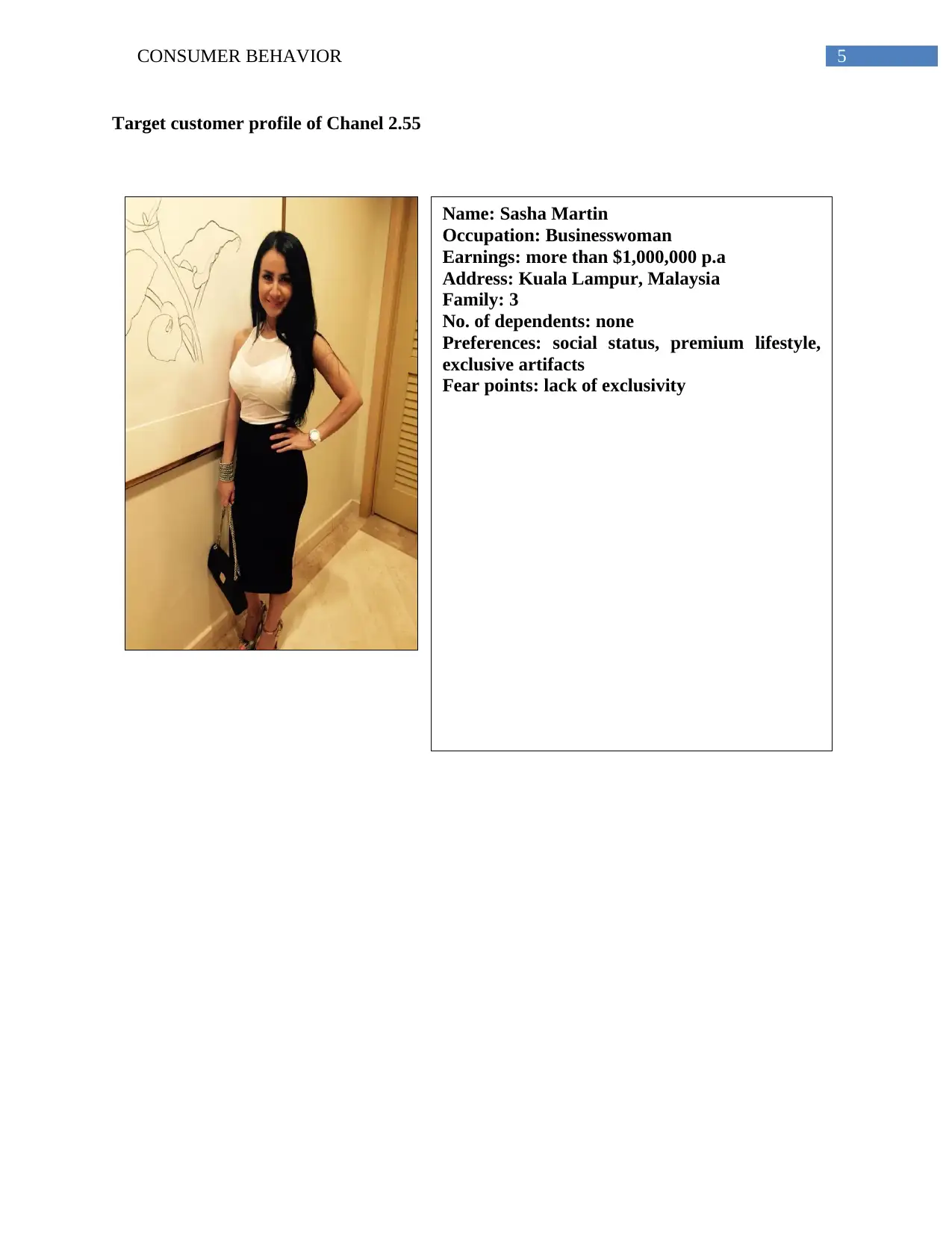
5CONSUMER BEHAVIOR
Name: Sasha Martin
Occupation: Businesswoman
Earnings: more than $1,000,000 p.a
Address: Kuala Lampur, Malaysia
Family: 3
No. of dependents: none
Preferences: social status, premium lifestyle,
exclusive artifacts
Fear points: lack of exclusivity
Target customer profile of Chanel 2.55
Name: Sasha Martin
Occupation: Businesswoman
Earnings: more than $1,000,000 p.a
Address: Kuala Lampur, Malaysia
Family: 3
No. of dependents: none
Preferences: social status, premium lifestyle,
exclusive artifacts
Fear points: lack of exclusivity
Target customer profile of Chanel 2.55
⊘ This is a preview!⊘
Do you want full access?
Subscribe today to unlock all pages.

Trusted by 1+ million students worldwide
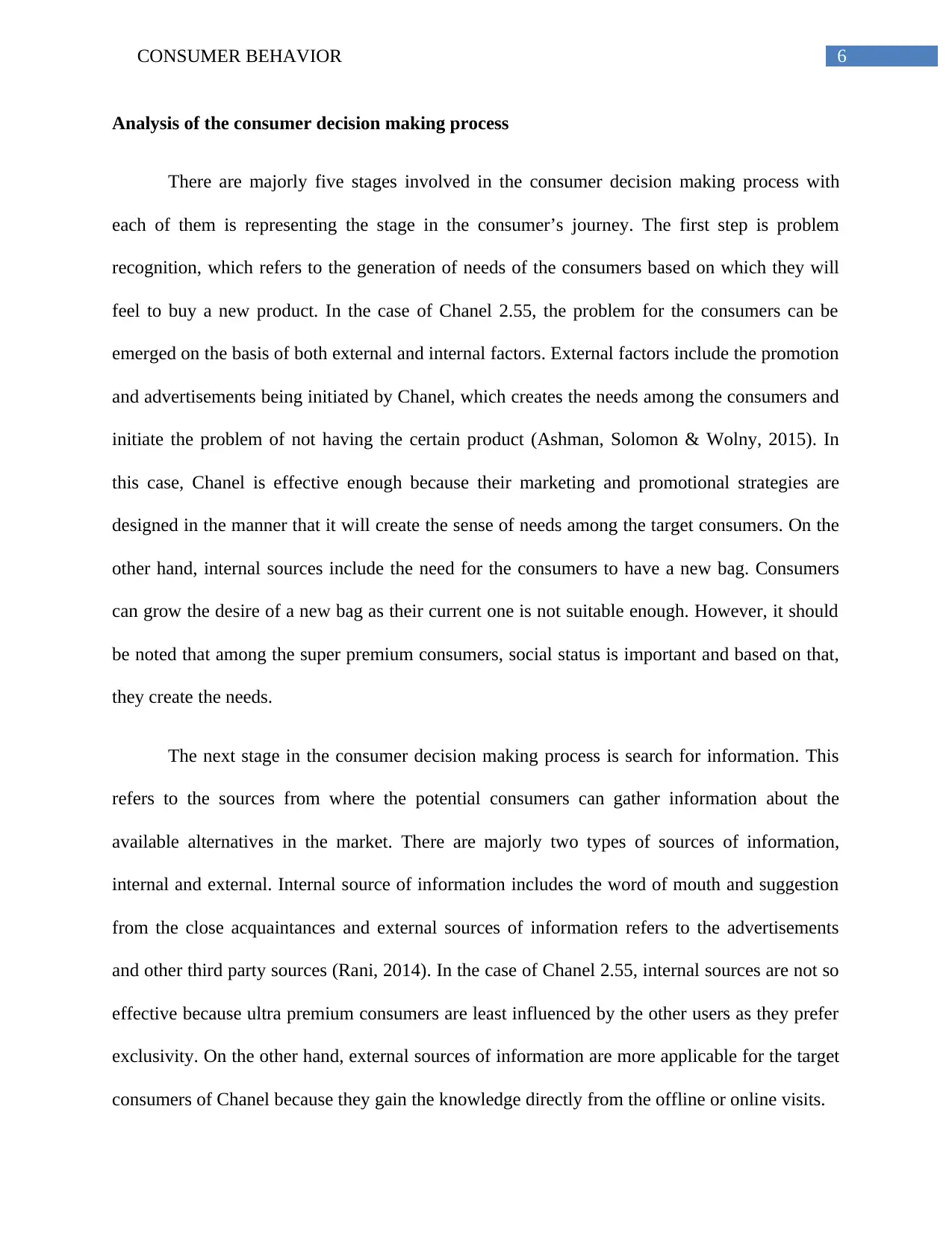
6CONSUMER BEHAVIOR
Analysis of the consumer decision making process
There are majorly five stages involved in the consumer decision making process with
each of them is representing the stage in the consumer’s journey. The first step is problem
recognition, which refers to the generation of needs of the consumers based on which they will
feel to buy a new product. In the case of Chanel 2.55, the problem for the consumers can be
emerged on the basis of both external and internal factors. External factors include the promotion
and advertisements being initiated by Chanel, which creates the needs among the consumers and
initiate the problem of not having the certain product (Ashman, Solomon & Wolny, 2015). In
this case, Chanel is effective enough because their marketing and promotional strategies are
designed in the manner that it will create the sense of needs among the target consumers. On the
other hand, internal sources include the need for the consumers to have a new bag. Consumers
can grow the desire of a new bag as their current one is not suitable enough. However, it should
be noted that among the super premium consumers, social status is important and based on that,
they create the needs.
The next stage in the consumer decision making process is search for information. This
refers to the sources from where the potential consumers can gather information about the
available alternatives in the market. There are majorly two types of sources of information,
internal and external. Internal source of information includes the word of mouth and suggestion
from the close acquaintances and external sources of information refers to the advertisements
and other third party sources (Rani, 2014). In the case of Chanel 2.55, internal sources are not so
effective because ultra premium consumers are least influenced by the other users as they prefer
exclusivity. On the other hand, external sources of information are more applicable for the target
consumers of Chanel because they gain the knowledge directly from the offline or online visits.
Analysis of the consumer decision making process
There are majorly five stages involved in the consumer decision making process with
each of them is representing the stage in the consumer’s journey. The first step is problem
recognition, which refers to the generation of needs of the consumers based on which they will
feel to buy a new product. In the case of Chanel 2.55, the problem for the consumers can be
emerged on the basis of both external and internal factors. External factors include the promotion
and advertisements being initiated by Chanel, which creates the needs among the consumers and
initiate the problem of not having the certain product (Ashman, Solomon & Wolny, 2015). In
this case, Chanel is effective enough because their marketing and promotional strategies are
designed in the manner that it will create the sense of needs among the target consumers. On the
other hand, internal sources include the need for the consumers to have a new bag. Consumers
can grow the desire of a new bag as their current one is not suitable enough. However, it should
be noted that among the super premium consumers, social status is important and based on that,
they create the needs.
The next stage in the consumer decision making process is search for information. This
refers to the sources from where the potential consumers can gather information about the
available alternatives in the market. There are majorly two types of sources of information,
internal and external. Internal source of information includes the word of mouth and suggestion
from the close acquaintances and external sources of information refers to the advertisements
and other third party sources (Rani, 2014). In the case of Chanel 2.55, internal sources are not so
effective because ultra premium consumers are least influenced by the other users as they prefer
exclusivity. On the other hand, external sources of information are more applicable for the target
consumers of Chanel because they gain the knowledge directly from the offline or online visits.
Paraphrase This Document
Need a fresh take? Get an instant paraphrase of this document with our AI Paraphraser
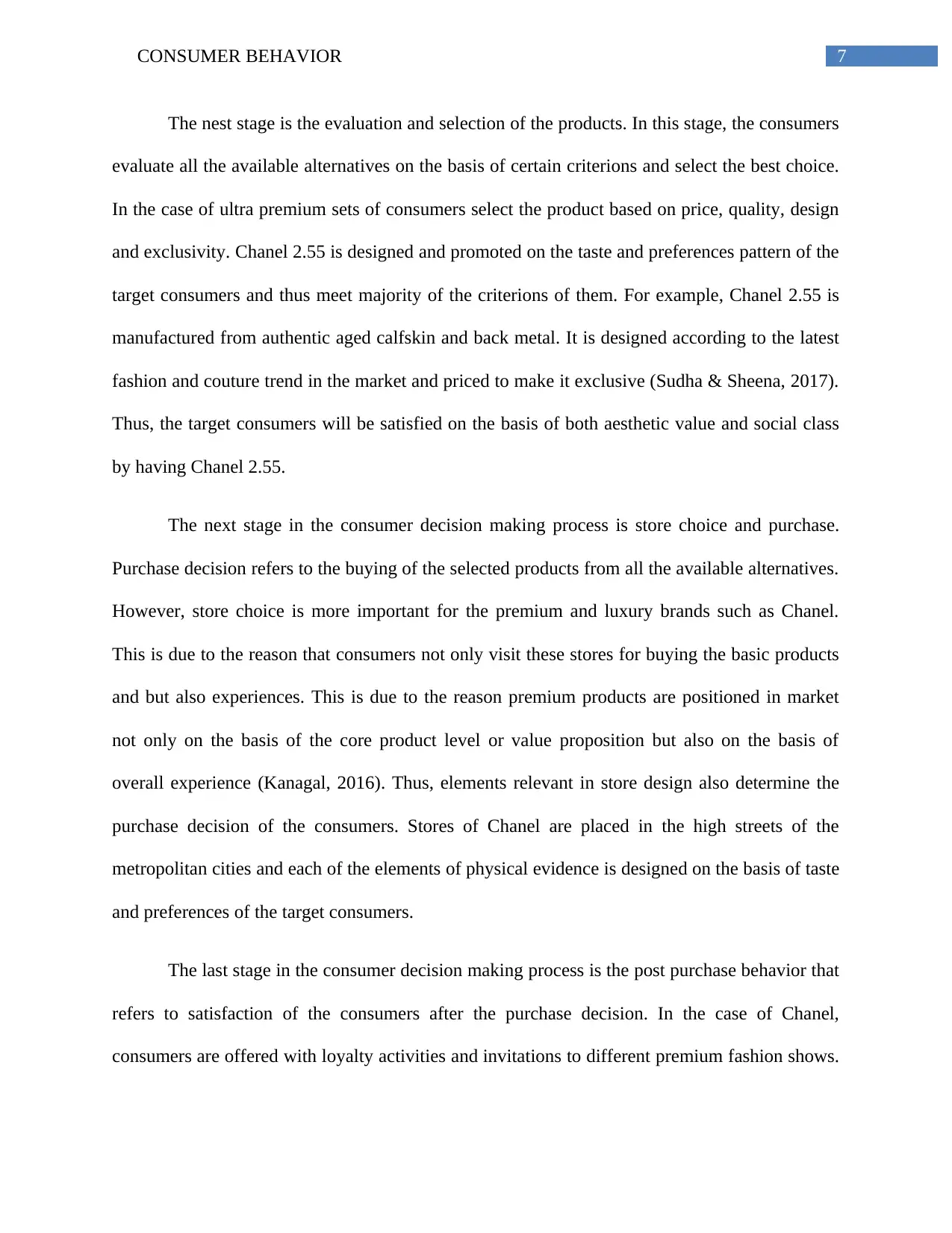
7CONSUMER BEHAVIOR
The nest stage is the evaluation and selection of the products. In this stage, the consumers
evaluate all the available alternatives on the basis of certain criterions and select the best choice.
In the case of ultra premium sets of consumers select the product based on price, quality, design
and exclusivity. Chanel 2.55 is designed and promoted on the taste and preferences pattern of the
target consumers and thus meet majority of the criterions of them. For example, Chanel 2.55 is
manufactured from authentic aged calfskin and back metal. It is designed according to the latest
fashion and couture trend in the market and priced to make it exclusive (Sudha & Sheena, 2017).
Thus, the target consumers will be satisfied on the basis of both aesthetic value and social class
by having Chanel 2.55.
The next stage in the consumer decision making process is store choice and purchase.
Purchase decision refers to the buying of the selected products from all the available alternatives.
However, store choice is more important for the premium and luxury brands such as Chanel.
This is due to the reason that consumers not only visit these stores for buying the basic products
and but also experiences. This is due to the reason premium products are positioned in market
not only on the basis of the core product level or value proposition but also on the basis of
overall experience (Kanagal, 2016). Thus, elements relevant in store design also determine the
purchase decision of the consumers. Stores of Chanel are placed in the high streets of the
metropolitan cities and each of the elements of physical evidence is designed on the basis of taste
and preferences of the target consumers.
The last stage in the consumer decision making process is the post purchase behavior that
refers to satisfaction of the consumers after the purchase decision. In the case of Chanel,
consumers are offered with loyalty activities and invitations to different premium fashion shows.
The nest stage is the evaluation and selection of the products. In this stage, the consumers
evaluate all the available alternatives on the basis of certain criterions and select the best choice.
In the case of ultra premium sets of consumers select the product based on price, quality, design
and exclusivity. Chanel 2.55 is designed and promoted on the taste and preferences pattern of the
target consumers and thus meet majority of the criterions of them. For example, Chanel 2.55 is
manufactured from authentic aged calfskin and back metal. It is designed according to the latest
fashion and couture trend in the market and priced to make it exclusive (Sudha & Sheena, 2017).
Thus, the target consumers will be satisfied on the basis of both aesthetic value and social class
by having Chanel 2.55.
The next stage in the consumer decision making process is store choice and purchase.
Purchase decision refers to the buying of the selected products from all the available alternatives.
However, store choice is more important for the premium and luxury brands such as Chanel.
This is due to the reason that consumers not only visit these stores for buying the basic products
and but also experiences. This is due to the reason premium products are positioned in market
not only on the basis of the core product level or value proposition but also on the basis of
overall experience (Kanagal, 2016). Thus, elements relevant in store design also determine the
purchase decision of the consumers. Stores of Chanel are placed in the high streets of the
metropolitan cities and each of the elements of physical evidence is designed on the basis of taste
and preferences of the target consumers.
The last stage in the consumer decision making process is the post purchase behavior that
refers to satisfaction of the consumers after the purchase decision. In the case of Chanel,
consumers are offered with loyalty activities and invitations to different premium fashion shows.
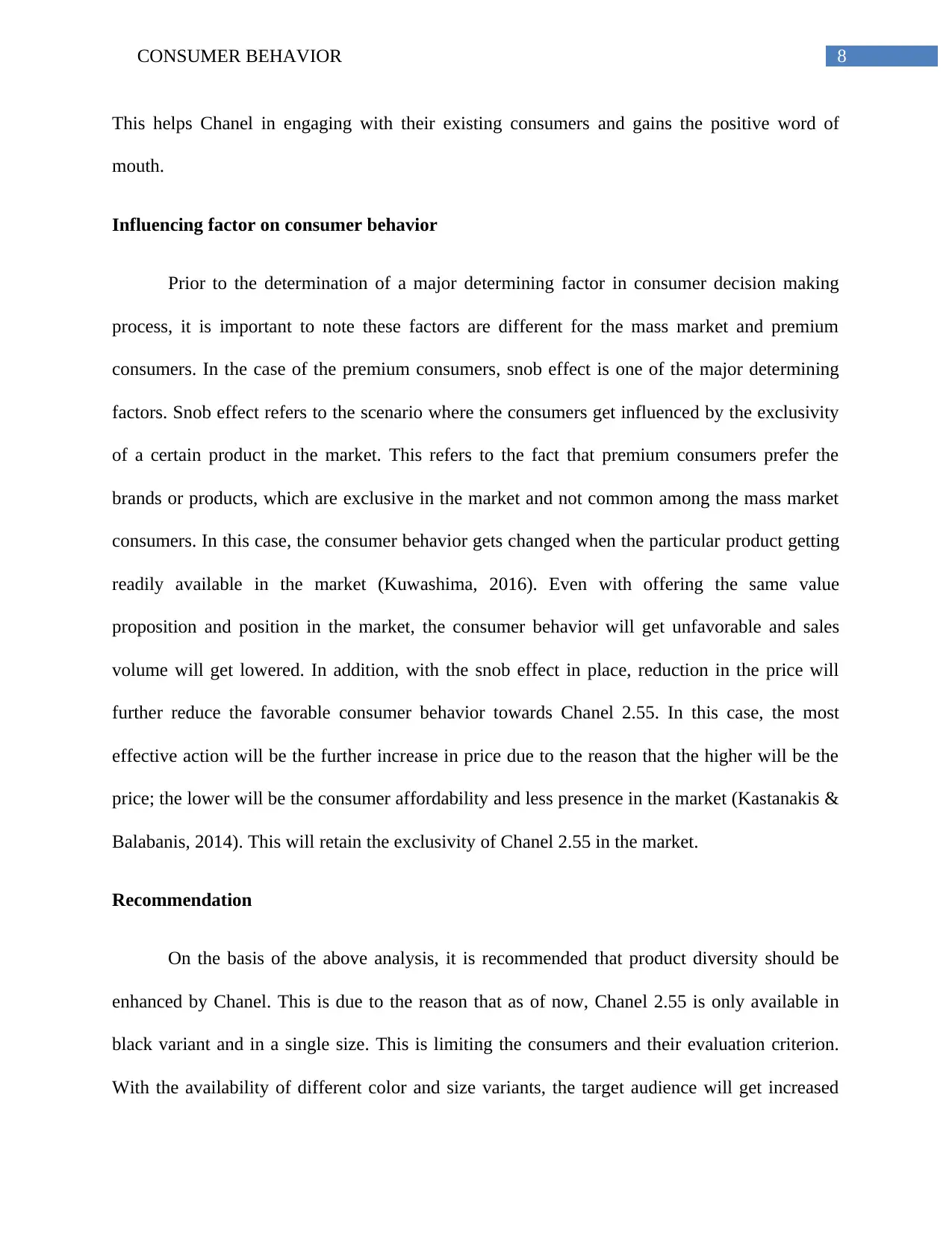
8CONSUMER BEHAVIOR
This helps Chanel in engaging with their existing consumers and gains the positive word of
mouth.
Influencing factor on consumer behavior
Prior to the determination of a major determining factor in consumer decision making
process, it is important to note these factors are different for the mass market and premium
consumers. In the case of the premium consumers, snob effect is one of the major determining
factors. Snob effect refers to the scenario where the consumers get influenced by the exclusivity
of a certain product in the market. This refers to the fact that premium consumers prefer the
brands or products, which are exclusive in the market and not common among the mass market
consumers. In this case, the consumer behavior gets changed when the particular product getting
readily available in the market (Kuwashima, 2016). Even with offering the same value
proposition and position in the market, the consumer behavior will get unfavorable and sales
volume will get lowered. In addition, with the snob effect in place, reduction in the price will
further reduce the favorable consumer behavior towards Chanel 2.55. In this case, the most
effective action will be the further increase in price due to the reason that the higher will be the
price; the lower will be the consumer affordability and less presence in the market (Kastanakis &
Balabanis, 2014). This will retain the exclusivity of Chanel 2.55 in the market.
Recommendation
On the basis of the above analysis, it is recommended that product diversity should be
enhanced by Chanel. This is due to the reason that as of now, Chanel 2.55 is only available in
black variant and in a single size. This is limiting the consumers and their evaluation criterion.
With the availability of different color and size variants, the target audience will get increased
This helps Chanel in engaging with their existing consumers and gains the positive word of
mouth.
Influencing factor on consumer behavior
Prior to the determination of a major determining factor in consumer decision making
process, it is important to note these factors are different for the mass market and premium
consumers. In the case of the premium consumers, snob effect is one of the major determining
factors. Snob effect refers to the scenario where the consumers get influenced by the exclusivity
of a certain product in the market. This refers to the fact that premium consumers prefer the
brands or products, which are exclusive in the market and not common among the mass market
consumers. In this case, the consumer behavior gets changed when the particular product getting
readily available in the market (Kuwashima, 2016). Even with offering the same value
proposition and position in the market, the consumer behavior will get unfavorable and sales
volume will get lowered. In addition, with the snob effect in place, reduction in the price will
further reduce the favorable consumer behavior towards Chanel 2.55. In this case, the most
effective action will be the further increase in price due to the reason that the higher will be the
price; the lower will be the consumer affordability and less presence in the market (Kastanakis &
Balabanis, 2014). This will retain the exclusivity of Chanel 2.55 in the market.
Recommendation
On the basis of the above analysis, it is recommended that product diversity should be
enhanced by Chanel. This is due to the reason that as of now, Chanel 2.55 is only available in
black variant and in a single size. This is limiting the consumers and their evaluation criterion.
With the availability of different color and size variants, the target audience will get increased
⊘ This is a preview!⊘
Do you want full access?
Subscribe today to unlock all pages.

Trusted by 1+ million students worldwide
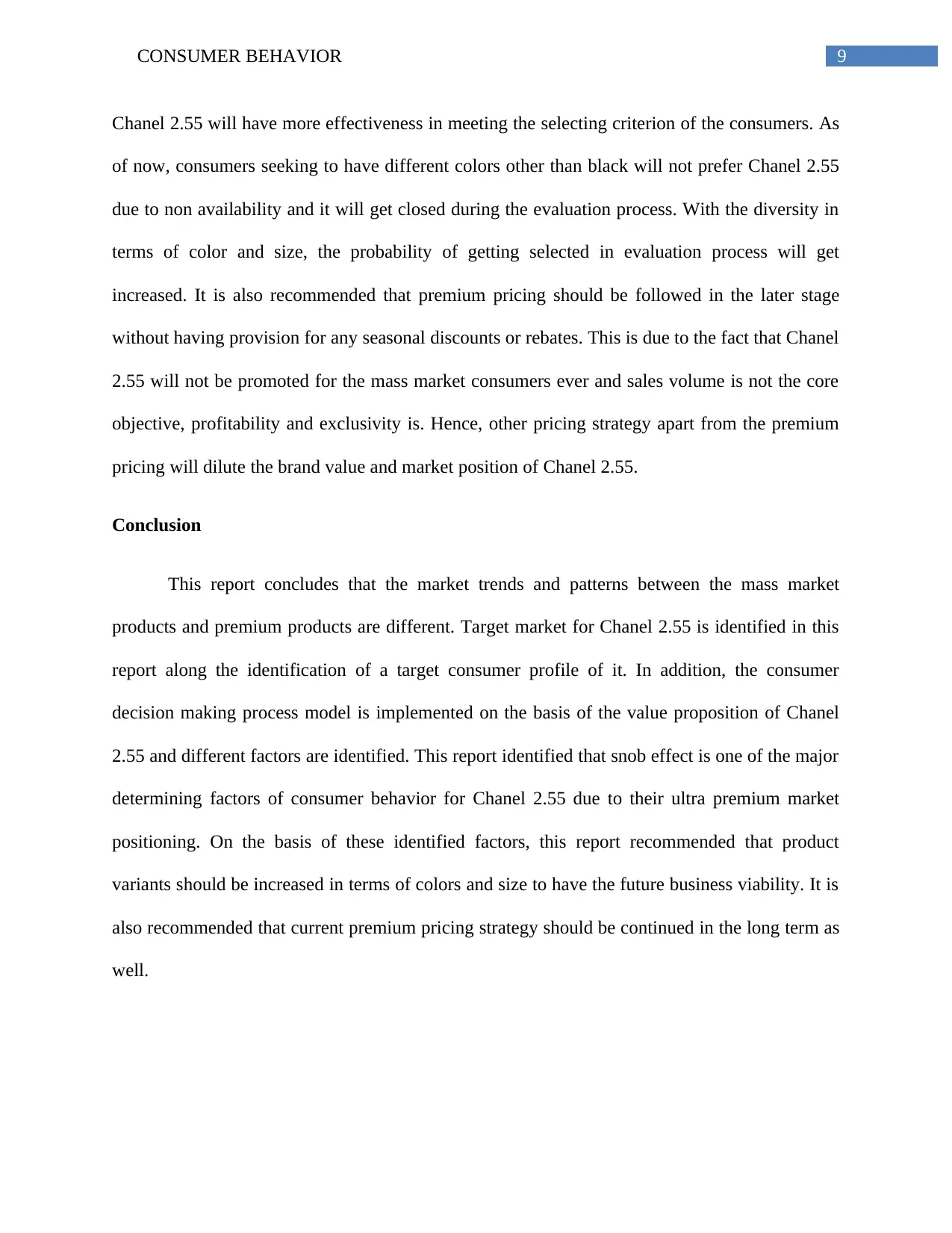
9CONSUMER BEHAVIOR
Chanel 2.55 will have more effectiveness in meeting the selecting criterion of the consumers. As
of now, consumers seeking to have different colors other than black will not prefer Chanel 2.55
due to non availability and it will get closed during the evaluation process. With the diversity in
terms of color and size, the probability of getting selected in evaluation process will get
increased. It is also recommended that premium pricing should be followed in the later stage
without having provision for any seasonal discounts or rebates. This is due to the fact that Chanel
2.55 will not be promoted for the mass market consumers ever and sales volume is not the core
objective, profitability and exclusivity is. Hence, other pricing strategy apart from the premium
pricing will dilute the brand value and market position of Chanel 2.55.
Conclusion
This report concludes that the market trends and patterns between the mass market
products and premium products are different. Target market for Chanel 2.55 is identified in this
report along the identification of a target consumer profile of it. In addition, the consumer
decision making process model is implemented on the basis of the value proposition of Chanel
2.55 and different factors are identified. This report identified that snob effect is one of the major
determining factors of consumer behavior for Chanel 2.55 due to their ultra premium market
positioning. On the basis of these identified factors, this report recommended that product
variants should be increased in terms of colors and size to have the future business viability. It is
also recommended that current premium pricing strategy should be continued in the long term as
well.
Chanel 2.55 will have more effectiveness in meeting the selecting criterion of the consumers. As
of now, consumers seeking to have different colors other than black will not prefer Chanel 2.55
due to non availability and it will get closed during the evaluation process. With the diversity in
terms of color and size, the probability of getting selected in evaluation process will get
increased. It is also recommended that premium pricing should be followed in the later stage
without having provision for any seasonal discounts or rebates. This is due to the fact that Chanel
2.55 will not be promoted for the mass market consumers ever and sales volume is not the core
objective, profitability and exclusivity is. Hence, other pricing strategy apart from the premium
pricing will dilute the brand value and market position of Chanel 2.55.
Conclusion
This report concludes that the market trends and patterns between the mass market
products and premium products are different. Target market for Chanel 2.55 is identified in this
report along the identification of a target consumer profile of it. In addition, the consumer
decision making process model is implemented on the basis of the value proposition of Chanel
2.55 and different factors are identified. This report identified that snob effect is one of the major
determining factors of consumer behavior for Chanel 2.55 due to their ultra premium market
positioning. On the basis of these identified factors, this report recommended that product
variants should be increased in terms of colors and size to have the future business viability. It is
also recommended that current premium pricing strategy should be continued in the long term as
well.
Paraphrase This Document
Need a fresh take? Get an instant paraphrase of this document with our AI Paraphraser
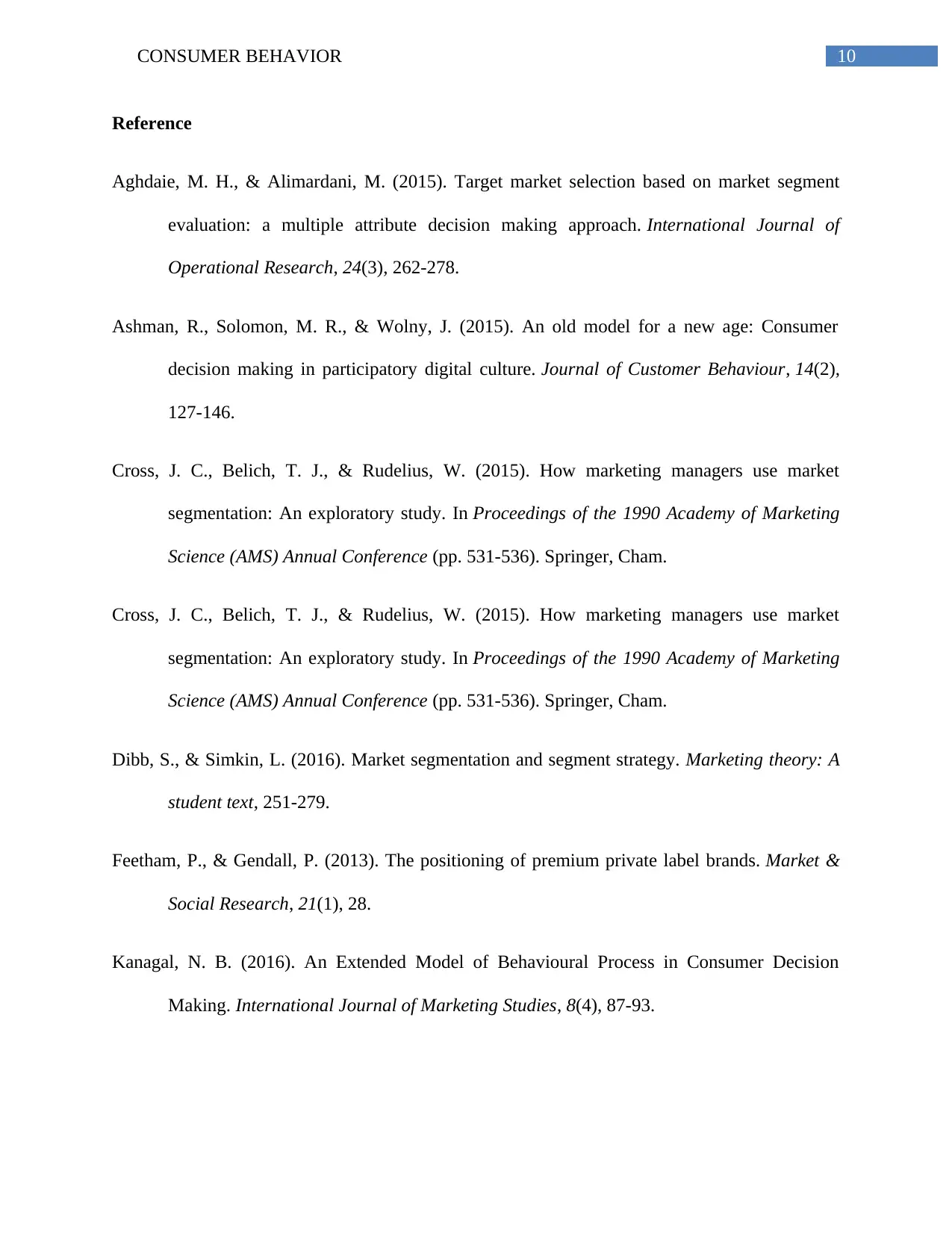
10CONSUMER BEHAVIOR
Reference
Aghdaie, M. H., & Alimardani, M. (2015). Target market selection based on market segment
evaluation: a multiple attribute decision making approach. International Journal of
Operational Research, 24(3), 262-278.
Ashman, R., Solomon, M. R., & Wolny, J. (2015). An old model for a new age: Consumer
decision making in participatory digital culture. Journal of Customer Behaviour, 14(2),
127-146.
Cross, J. C., Belich, T. J., & Rudelius, W. (2015). How marketing managers use market
segmentation: An exploratory study. In Proceedings of the 1990 Academy of Marketing
Science (AMS) Annual Conference (pp. 531-536). Springer, Cham.
Cross, J. C., Belich, T. J., & Rudelius, W. (2015). How marketing managers use market
segmentation: An exploratory study. In Proceedings of the 1990 Academy of Marketing
Science (AMS) Annual Conference (pp. 531-536). Springer, Cham.
Dibb, S., & Simkin, L. (2016). Market segmentation and segment strategy. Marketing theory: A
student text, 251-279.
Feetham, P., & Gendall, P. (2013). The positioning of premium private label brands. Market &
Social Research, 21(1), 28.
Kanagal, N. B. (2016). An Extended Model of Behavioural Process in Consumer Decision
Making. International Journal of Marketing Studies, 8(4), 87-93.
Reference
Aghdaie, M. H., & Alimardani, M. (2015). Target market selection based on market segment
evaluation: a multiple attribute decision making approach. International Journal of
Operational Research, 24(3), 262-278.
Ashman, R., Solomon, M. R., & Wolny, J. (2015). An old model for a new age: Consumer
decision making in participatory digital culture. Journal of Customer Behaviour, 14(2),
127-146.
Cross, J. C., Belich, T. J., & Rudelius, W. (2015). How marketing managers use market
segmentation: An exploratory study. In Proceedings of the 1990 Academy of Marketing
Science (AMS) Annual Conference (pp. 531-536). Springer, Cham.
Cross, J. C., Belich, T. J., & Rudelius, W. (2015). How marketing managers use market
segmentation: An exploratory study. In Proceedings of the 1990 Academy of Marketing
Science (AMS) Annual Conference (pp. 531-536). Springer, Cham.
Dibb, S., & Simkin, L. (2016). Market segmentation and segment strategy. Marketing theory: A
student text, 251-279.
Feetham, P., & Gendall, P. (2013). The positioning of premium private label brands. Market &
Social Research, 21(1), 28.
Kanagal, N. B. (2016). An Extended Model of Behavioural Process in Consumer Decision
Making. International Journal of Marketing Studies, 8(4), 87-93.
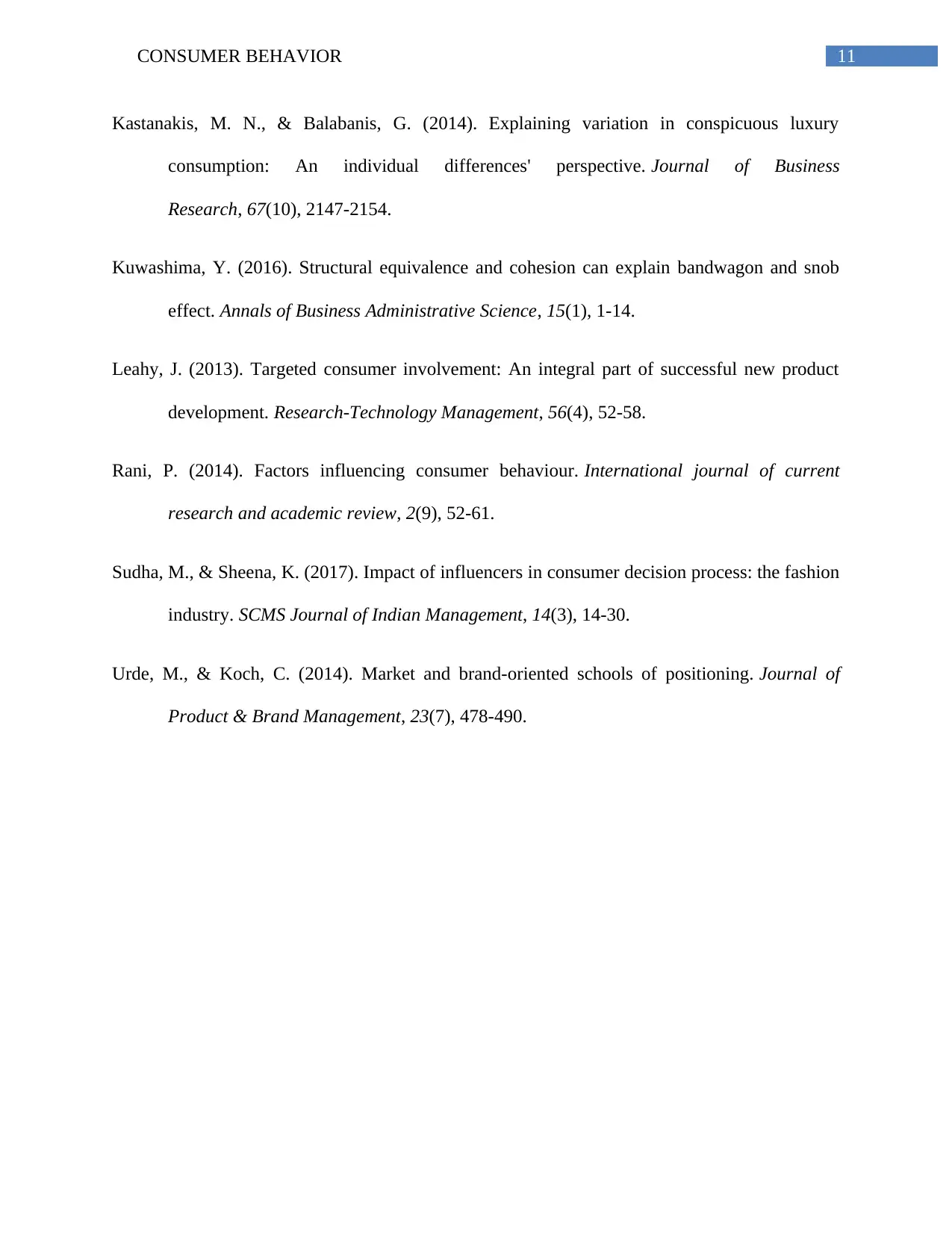
11CONSUMER BEHAVIOR
Kastanakis, M. N., & Balabanis, G. (2014). Explaining variation in conspicuous luxury
consumption: An individual differences' perspective. Journal of Business
Research, 67(10), 2147-2154.
Kuwashima, Y. (2016). Structural equivalence and cohesion can explain bandwagon and snob
effect. Annals of Business Administrative Science, 15(1), 1-14.
Leahy, J. (2013). Targeted consumer involvement: An integral part of successful new product
development. Research-Technology Management, 56(4), 52-58.
Rani, P. (2014). Factors influencing consumer behaviour. International journal of current
research and academic review, 2(9), 52-61.
Sudha, M., & Sheena, K. (2017). Impact of influencers in consumer decision process: the fashion
industry. SCMS Journal of Indian Management, 14(3), 14-30.
Urde, M., & Koch, C. (2014). Market and brand-oriented schools of positioning. Journal of
Product & Brand Management, 23(7), 478-490.
Kastanakis, M. N., & Balabanis, G. (2014). Explaining variation in conspicuous luxury
consumption: An individual differences' perspective. Journal of Business
Research, 67(10), 2147-2154.
Kuwashima, Y. (2016). Structural equivalence and cohesion can explain bandwagon and snob
effect. Annals of Business Administrative Science, 15(1), 1-14.
Leahy, J. (2013). Targeted consumer involvement: An integral part of successful new product
development. Research-Technology Management, 56(4), 52-58.
Rani, P. (2014). Factors influencing consumer behaviour. International journal of current
research and academic review, 2(9), 52-61.
Sudha, M., & Sheena, K. (2017). Impact of influencers in consumer decision process: the fashion
industry. SCMS Journal of Indian Management, 14(3), 14-30.
Urde, M., & Koch, C. (2014). Market and brand-oriented schools of positioning. Journal of
Product & Brand Management, 23(7), 478-490.
⊘ This is a preview!⊘
Do you want full access?
Subscribe today to unlock all pages.

Trusted by 1+ million students worldwide
1 out of 12
Related Documents
Your All-in-One AI-Powered Toolkit for Academic Success.
+13062052269
info@desklib.com
Available 24*7 on WhatsApp / Email
![[object Object]](/_next/static/media/star-bottom.7253800d.svg)
Unlock your academic potential
Copyright © 2020–2025 A2Z Services. All Rights Reserved. Developed and managed by ZUCOL.





